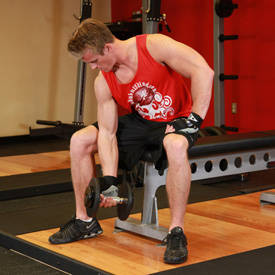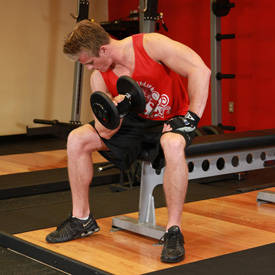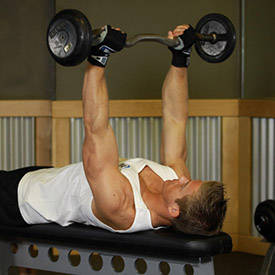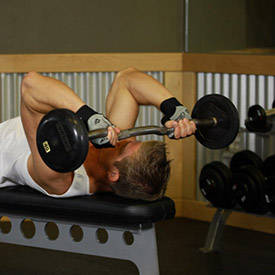"Dude, get your guns out!" Now I'm almost certain you've heard that before. Pretty much anyone who lifts weights seriously has heard that. People are quite fascinated by muscle. The biceps and triceps are two muscle groups that people absolutely love to show off. In fact, a lot of people who weight train probably started by only training their arms.
To build a huge pair of arms, you need a solid training routine to maximize their development; you can't just curl for hours on end everyday. Arm training is a bit of a funny one. It seems that lots of people "know best" and yet they all have different opinions. This article isn't intended to force yet another opinion upon you, it's simply to give you a view of arm training based on research and experience.
Biceps


Concentration Curls
As the name suggests, this is a two-headed muscle; a short head and a long head. To maximally develop the biceps, both of these must be given equal attention. The main method of targeting each of the heads of the biceps is to frequently alternate the grip and arm positioning when performing biceps exercises. I will explain more about this later.
The brachialis is another part of the biceps. It sits deep into the biceps muscle, and is visible on the outside of the biceps and at the top of the forearm. It is rare to see a well developed brachialis on people who do not specifically train it.
Not only does the brachialis help with forearm size and overall biceps strength, but over time it increases the 'peak' that so many people strive to achieve. I can't stress how much I believe in training the brachialis as well.
I often see guys at my gym, who are the same age as me, performing an absurd amount of isolation exercises for their biceps, and yet they're doing so to, and I quote, "Build massive arms". I very much disagree with this. Would you try to build huge shoulders using only isolation exercises such as raises? No, of course not. So why treat the biceps any different?
Now when I say isolation exercises, I'm not just talking about exercises like concentration curls, spider curls or preacher curls. I'm talking about curls in general.
The definition of a compound movement is an exercise that uses more than one muscle group to assist the lift. Some examples would be deadlifts, presses, rows and squats.
People will often tell you that barbell and dumbbell curls are the compound movements for the biceps. These are likely to be the same people who tell you not to use momentum to assist the lift. Why? Because momentum causes you to use other muscle groups. Do you see where I'm going with this?
In restricting the use of other muscle groups, you're pretty much destroying the point of a compound movement. This is why I feel any sort of curl is an isolation exercise. For a lot of people, this will leave you with no exercises left to work your biceps. Allow me to enlighten you.
Biceps Rows
That's right, biceps rows. Have you ever performed an underhand bent over row, and felt a strong contraction in your biceps? Well a biceps row is very similar to this. Effectively, you're performing a bent over row, but using the biceps to move the weight.
Attach a long bar to the low pulley of the cable crossover apparatus in your gym. Bend over about to about half way between upright and 90 degrees. Grasp the bar using an underhand style shoulder width grip. Pull the bar into your upper ab region. Focus on using the biceps to perform the lift.


CLose-Grip Front Lat Pulldown
If you perform this exercise correctly, you will feel a contraction and pump in your biceps greater than anything you've ever felt! This will obviously recruit some of the fibers in your back as well, but then all other compound movements affect other body parts as well.
You may be very hesitant about this exercise, but I ask you to give it a try. I'm almost certain that once you've performed this exercise, you will include it in almost every biceps workout you do!
The same principle can be used for close-grip pull-downs as well. Instead of pulling the bar down to your sternum, focus more on using the biceps to pull it to your clavicle. This variation also gives the brachialis a decent beating as well.
Other Biceps Exercises
Other than the many variations of the biceps row, I will now list the exercises that I feel will benefit teenagers the most.
Outer Head And Brachialis Emphasis
- Close-Grip EZ Bar Curl
- Preacher Curl
- Two-Arm Dumbbell Preacher Curl
- Hammer Curls
- Cable Hammer Curls - Rope Attachment
- Incline Dumbbell Curl
Inner Head Emphasis
- Dumbbell Bicep Curl
- Barbell Curl
- Reverse Cable Curl
- Preacher Curl
I feel that these exercises will focus more on pure hypertrophy and building mass, rather than improving separation and detail. When performing all of these exercises, I recommend a 1 second concentric and a 1.5-2 second eccentric.
The biceps are a muscle group designed for slower movements, and so a slower rep cadence seems sensible. This is a fact that a lot of people overlook. Different muscles are designed for different things. An example would be the triceps.
You use the triceps when punching, a very explosive action. So, using a more explosive rep cadence would seem fitting. Likewise, the biceps are designed for slower actions, such as carrying things. Common sense would then suggest that using a slower rep cadence would be more beneficial for pure hypertrophy.
As I mentioned earlier, people often see barbell curls as a compound movement. While I don't agree with this, I do feel that they are an essential exercise for developing the biceps fully. I also don't agree that you shouldn't use momentum to lift the weight. The body is designed to work as a unit.
A little off subject, but sneezing is a perfect example of this. You will never be able to only move a single body part when sneezing. Doing so would be going against your body's natural reflex. The same should be considered when performing barbell curls.
If a small amount of hip movement can help you use slightly more weight, then you should do so. Now saying that, I'm not suggesting that you should move so much that people think you're trying to make love to the weight. I'm also not saying you should lean back, as this can lead to severe injury.
Just a small amount of hip movement to assist the lift. You should also consider that your biceps are at their weakest when fully extended. They are at their strongest when at roughly a 90 degree angle.
Using momentum will assist the biceps when they are at their weakest, while they work the hardest in their strongest position. This is just my theory, and I'm not implying that anyone who says different is wrong, but I see logic in this theory, and so I believe it to be effective.
Triceps
The triceps are a three-headed muscle group, which consists of a long, lateral and medial head. Once again, in order to fully develop the triceps, each of these heads must be given the appropriate amount of attention.
The way to shift focus to different heads of the triceps, is to adjust the position of your elbows. To try and help you visualize this, think about performing dumbbell French presses. If you have your elbows flared out wide, you will be working the long head more than the others.
The closer together your elbows are positioned, the more emphasis you place on the lateral head. The medial head is quite difficult to isolate because of where it is positioned, but many people I have spoken to have found that shoulder width reverse-grip press-downs hit this portion of the triceps extremely well.
Much like the biceps, people at my gym often perform many isolation exercises for the triceps, and miss out on the "bread and butter" exercises like close-grip bench presses. One difference between the biceps and the triceps is that more isolation is required for the triceps. This is largely due to the separation in the triceps heads being more profound that those of the biceps.
Triceps Exercises
Before I list the exercises that I believe to be most effective in building triceps mass, I want to explain how some of the exercises can be performed.
Close-grip bench presses sound pretty simple—bench presses, but with your hands closer together. This is pretty much correct. However, some people say that you should have your hands about 4-6 inches apart. I don't agree. This places a lot of stress on your wrists. Also, the reason this variation of the bench press hits your triceps, is because your upper arms are tucked close to your body.
You'll find that your elbows flare out much less if you have your hands at a shoulder width, or very slightly less than shoulder width grip. This also places much less stress on your wrists. I recommend performing close-grip bench presses like this.


Lying Triceps Press
Skull crushers place a fair amount of stress on the elbows. A way to minimize this is to bring the bar down behind your head, instead of to your forehead. This will require you to move your upper arms back slightly. You may also find that this creates more of a stretch on the triceps, which might be beneficial too.
I mentioned French presses earlier. I personally don't perform these any more. They hurt my elbows a lot, so I don't feel I can tell you how to perform these safely. I would suggest that you fully warm up your elbows before performing them. Experiment with them and find what's comfortable for you. If you feel any pain in your elbows, rotator cuffs or wrists... STOP!
With just about every other triceps exercise, my advice is to perform them in a way that is comfortable for you. Changing the positioning of your elbows on a regular basis will ensure that you work all of the heads of the triceps.
Think of it this way. When you have your elbows close to your body, you primarily work the portion of the triceps that are furthest away from your body, and vice versa. This is an extremely general rule, and is different for each person, but it should provide a guideline as to what needs to be done to shift emphasis as desired.
I am now going to list some of the exercises that I feel will benefit teenagers the most:
Long-Head Emphasis
- Triceps Push-down - V-Bar Attachment
- Triceps Push-down - Rope Attachment
- Lying Triceps Press
- Lying Supine Dumbbell Curl
- Triceps Push-down
Lateral Head Emphasis
- Close-Grip Barbell Bench Press
- Lying Triceps Press
- Triceps Push-down
Medial Head Emphasis
- Cable One-Arm Tricep Extension
- Underhand Cable Pull-downs
These are the exercises that I prefer to use. I'm not suggesting that you should only use these. For all of these exercises, if training for pure hypertrophy, I recommend a 0.5 second concentric, and a 1 second eccentric. This explosive cadence is specific to the triceps, and may be counter productive if utilized for other muscle groups.
Volume
I've always been quite interested in volume. Some people can use a lot and not overtrain, some people can barely use any volume at all. Some, such as myself, don't grow unless they use very high volume. While volume is relative to the individual, it's also relative to the body part. It's very simple.
Bigger muscle groups need and can get away with more volume, and smaller ones less volume. For average teenagers who have been training for 1-3 years, I suggest using 4-8 sets for both biceps and triceps individually. This is only a guideline however, and you should use as much volume as you need. Using more volume probably won't be a problem, but it may cause difficulties in the future.
The longer you've trained for, the more volume you will require to continue to overload your muscles. If you're blasting out 20 sets for your biceps now, imagine what you'll need in 10 or more years time.
Here is a sample arm training routine geared towards rapid hypertrophy:
Sample Routine
- Smith Machine Bent-Over Row: 2 sets of 6-12 reps
- Barbell Curl: 2 sets of 6-12 reps
- Preacher Curl: 2 sets of 6-12 reps
- Close-Grip Barbell Bench Press: 2 sets of 6-12 reps
- Lying Triceps Press: 2 sets of 6-12 reps
- Underhand Cable Pull-downs: 2 sets of 6-12 reps
This workout hits every part of the biceps and the triceps. This is just one of many routines that can be put together to ensure full arm development.
I hope this article has given you a wider view as to how you can maximize the development of your arms. Putting this into practice and doing so consistently will give you some outstanding results. As always you should keep your body in an optimal recovery state by maintaining a good nutritional plan.
Lift hard, Eat big, GROW!
